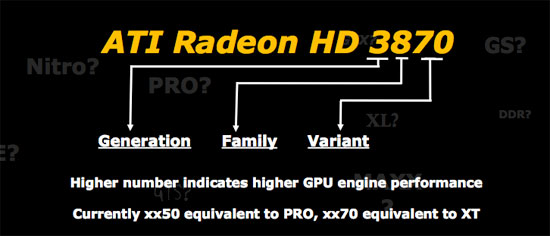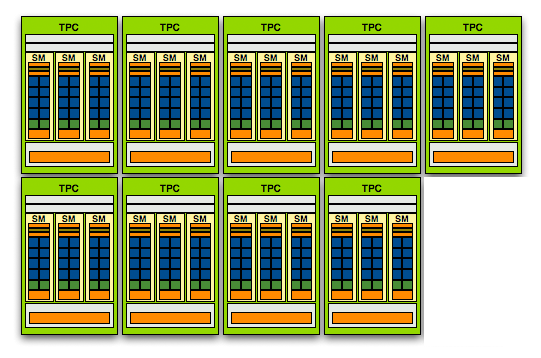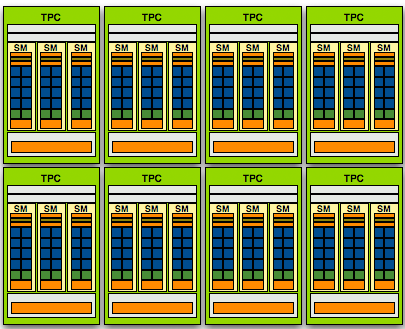NVIDIA GeForce GTX 260 Core 216: Competition for the 4870
by Anand Lal Shimpi & Derek Wilson on September 16, 2008 12:00 AM EST- Posted in
- GPUs
Nearly a year ago I wrote about something I called "sensible naming" with respect to GPUs. It was at the time of the Radeon HD 3800 series launch where AMD unveiled a much cleaner, simpler way of naming its cards. Gone were the suffixes (for the most part) and instead what we were left with was this:

A family name, Radeon HD, followed by a four digit number. With the exception of the X2s, AMD has stuck to its naming system without fault. In fact, AMD has done such a good job with keeping the names clean that things are the way they should be: the internal codenames are more difficult to remember than the actual names of the cards (e.g. RV770 vs. Radeon HD 4870).
NVIDIA however, just hasn't gotten the hint. The GT200 launch gave us two simply named cards: the GeForce GTX 280 and GTX 260, but it didn't take long for NVIDIA to confuse the marketplace with the launch of the GeForce 9800 GTX+. I hoped that the naming silliness was limited to the older GeForce 9 GPUs, but today it extended into the GTX lineup.
It's called the GeForce GTX 260 Core 216.

Holy nomenclature Batman
The GeForce GTX 260 Core 216's name is actually quite descriptive, albeit absurdly long. The GeForce GTX 260 part we already know from the GT200 launch, the Core 216 suffix just indicates that the GPU has 216 "cores" (also playing on Intel's new Core i7 naming for Nehalem, due out later this year). Why NVIDIA didn't just call it a GeForce GTX 265 or 270 is beyond me. To make matters worse, we'll see companies adding their own suffixes to the already extended name. For example, EVGA sent us their Core 216 called the EVGA GeForce GTX 260 Core 216 Superclocked Edition. Perhaps it's some conspiracy to increase the salary of writers who get paid by the word.
| GTX 280 | GTX 260 Core 216 | GTX 260 | 9800 GTX+ | 9800 GT | |
| Stream Processors | 240 | 216 | 192 | 128 | 112 |
| Texture Address / Filtering | 80 / 80 | 72/72 | 64 / 64 | 64 / 64 | 56 / 56 |
| ROPs | 32 | 28 | 28 | 16 | 16 |
| Core Clock | 602MHz | 576MHz | 576MHz | 738MHz | 600MHz |
| Shader Clock | 1296MHz | 1242MHz | 1242MHz | 1836MHz | 1500MHz |
| Memory Clock | 1107MHz | 999MHz | 999MHz | 1100MHz | 900MHz |
| Memory Bus Width | 512-bit | 448-bit | 448-bit | 256-bit | 256-bit |
| Frame Buffer | 1GB | 896MB | 896MB | 512MB | 512MB |
| Transistor Count | 1.4B | 1.4B | 1.4B | 754M | 754M |
| Manufacturing Process | TSMC 65nm | TSMC 65nm | TSMC 65nm | TSMC 55nm | TSMC 55nm |
| Price Point | $420 - $500 | $279 | $250 - $300 | $200 | $130 - $170 |
If you remember the diagram below from our GT200 review you'll see that a GeForce GTX 280 has ten clusters of 24 stream processors (the little blue blocks), for a total of 240 SPs or "cores". The GeForce GTX 260 has eight of those clusters (called Texture/Processor Clusters or TPCs), bringing its total up to 192 SPs. The Core 216, as you can guess, has nine clusters or 216 SPs. NVIDIA just enabled another TPC on the Core 216 (or alternatively, disabled a TPC on a GTX 280).

The GeForce GTX 280, 10 TPCs, 240 SPs

The GeForce GTX 260 Core 216, 9 TPCs, 216 SPs

The GeForce GTX 260, 8 TPCs, 192 SPs
The extra TPC also gives the Core 216 another 8 texture address and filtering units, but the rest of the chip's makeup remains the same, even down to the clock speeds. The Core 216 runs its core, shader and memory clocks at the same frequencies as the vanilla GTX 260.
Priced at $279, the Core 216 is a direct competitor to AMD's Radeon HD 4870 - selling at a similar price. The GTX 260 will continue to exist although selling at a cheaper price point and naturally with more processing power, the GTX 280 remains unaffected.










65 Comments
View All Comments
helldrell666 - Tuesday, September 16, 2008 - link
At 1920x1200 res. the 4870 beats the new 260gtx in all the tested games.the 4870 has only 512MB of ram so it's not fair to taste at 2560x1600 res.MrSpadge - Tuesday, September 16, 2008 - link
And if AMD put only 128 MB on that card people should only test it at 1024x768, because anything else is not fair?Come on, the lower resolutions are included in the detailed charts and the conclusion clearly says currently the 4870 is better.
MrS
helldrell666 - Tuesday, September 16, 2008 - link
Well,It's not fair to put the results at 2560res. on the top.They could've put the results at 1920 res. on the top.I think it's intentional,to show the 4870 in a worse case.
I know anandtech.they are AMD fanatics.simply, they don't like AMD.
Anyways, im waiting for the review of this card on techreport.com.
theoflow - Tuesday, September 16, 2008 - link
BUT CAN WE PLEASE GET A SYSTEM BUILDER GUIDE NOW???Thank you.
=)
JarredWalton - Tuesday, September 16, 2008 - link
I'll see about addressing that as soon as I finish my current article. I've been meaning to do one for months, but you know what they say about good intentions....Chaotic42 - Tuesday, September 16, 2008 - link
I would love to see one too, but if you're really going to do a new one, and I hope you do, please start doing them regularly. Maybe once per season or fiscal quarter? Monthly might be a bit much, but those system guides are fantastic.theoflow - Tuesday, September 16, 2008 - link
Cool thanks man. I'm itching to build a new rig, but been too busy to keep up with all the changes over the past year or so.MrSpadge - Tuesday, September 16, 2008 - link
Hi guys,I read somewhere that the first batches of 48x0 cards had a bug in their bios which prevented power play from working properly. This is supposed to be fixed since some time now and idle power draw should be decreased significantly.
I'd say contact AMD or a card manufacturer. If it's true they should be more than happy to assist you in obtaining updated numbers. The current numbers are just plain horrible and may keep people from buying the Radeons.
Regards, MrS
Mr Roboto - Tuesday, September 16, 2008 - link
Powerplay works fine on my reference VisionTek 4870 512MB.MrSpadge - Wednesday, September 17, 2008 - link
That's nice for you, but it still looks like it's not working on ATs card.Derek, did you hear me?
MrS